Key takeaways
- Natural light enhances photos with warmth and authenticity, connecting the indoors to the outside world.
- Choosing locations with large windows and diffusing direct sunlight can dramatically improve indoor photography results.
- Timing shoots during the golden hours can provide soft, magical lighting that transforms a scene.
- Embracing shadows and experimenting with angles can create depth and intrigue in photographs taken in natural light.
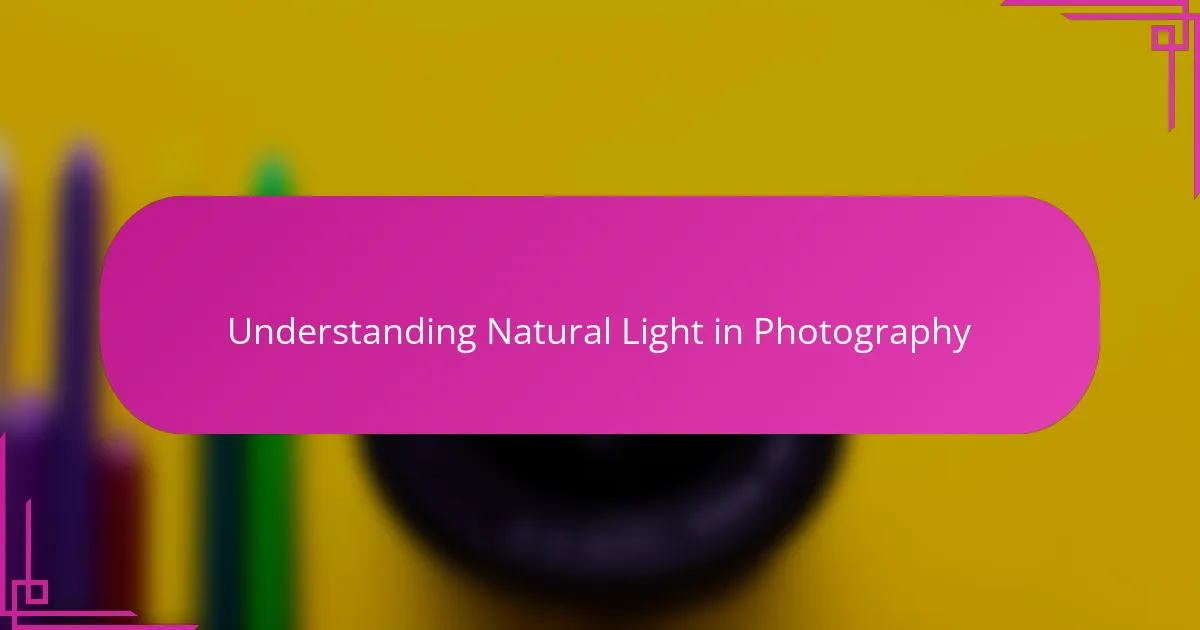
Understanding natural light in photography
Natural light is a remarkable element in photography—it’s ever-changing, unpredictable, and full of character. I often find myself marveling at how a simple shift in the sun’s angle can completely transform a scene. Have you ever noticed how the warmth of the morning light creates a soft glow, while the harsh midday sun casts sharp shadows?
For me, understanding natural light means knowing when and where to find it indoors, and how it interacts with the space around me. It’s almost like a dance between the light and the environment, revealing textures and colors that artificial lights just can’t replicate. Sometimes, I follow the path of sunlight through my windows, waiting for that perfect moment to capture something truly authentic.
But why is natural light so captivating? I believe it’s because it connects us to the outside world, even when we’re indoors. It breathes life into our photos, adding depth and emotion that tell a story beyond what’s simply seen. This is why learning to read and use natural light feels less like a technical skill and more like developing a new way to see the world.
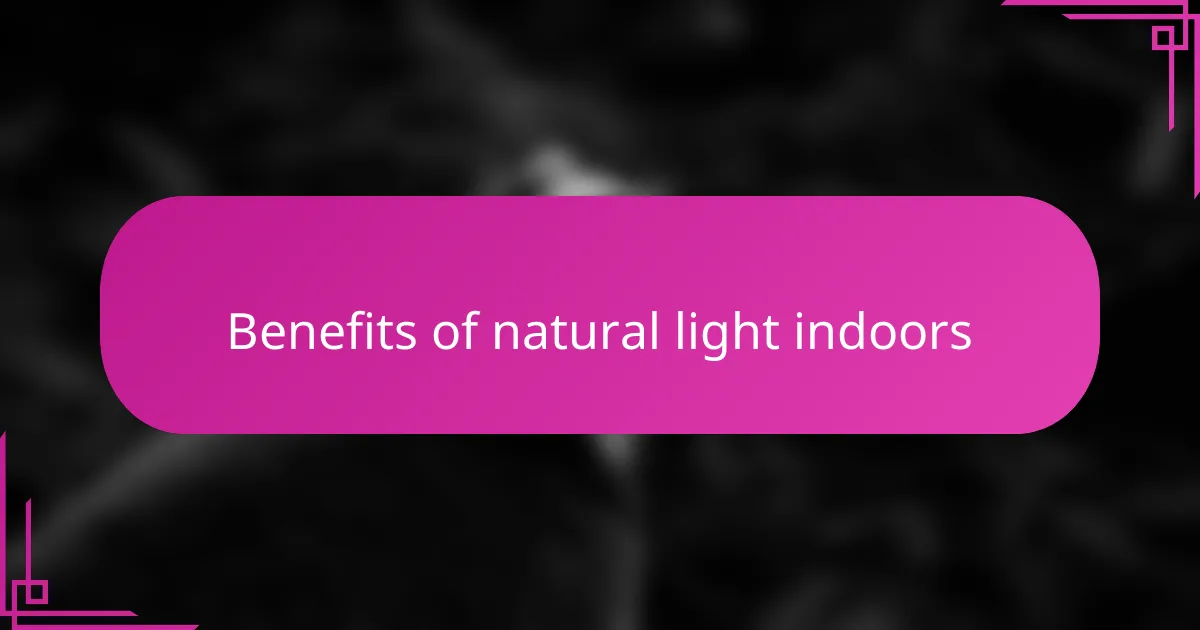
Benefits of natural light indoors
There’s something uniquely comforting about natural light indoors that I often find missing with artificial sources. It wraps around the subject gently, creating a warmth that feels alive—almost like the space itself is breathing. Have you ever noticed how a sunbeam slicing through a window can make the simplest room feel magical?
For me, natural light’s ability to change throughout the day offers endless creative possibilities. Morning light brings softness and calm, while evening light tends to be rich and dramatic. Capturing these moods without any extra equipment makes photography feel more spontaneous and authentic.
I also appreciate how natural light reveals textures and colors in ways that artificial lighting rarely can. It has this honest quality that breathes life into indoor shots, making them feel vibrant rather than staged. Don’t you think photos taken in natural light tell a story that’s deeper and more human?

Choosing the best indoor locations
When I scout for indoor locations, I always look for spaces with large windows or glass doors—these are natural light goldmines. Have you ever noticed how a corner bathed in soft window light can become an instant studio? It’s fascinating how even the simplest rooms can transform if the light is right.
Sometimes, I choose spots where the light filters through sheer curtains or bounces off light-colored walls. This subtle diffusion creates a gentle glow that flatters any subject. I remember one shoot in a friend’s cozy living room where the afternoon light spilled through lace curtains, casting the most enchanting patterns—pure magic without a single lamp.
I’m also drawn to places with interesting architectural features like skylights or bay windows. They add dimension and character by directing natural light in unique ways. Doesn’t the way sunlight plays around those spots inspire you to experiment with angles and shadows? For me, finding these special indoor corners feels like uncovering hidden gems waiting to tell their story.
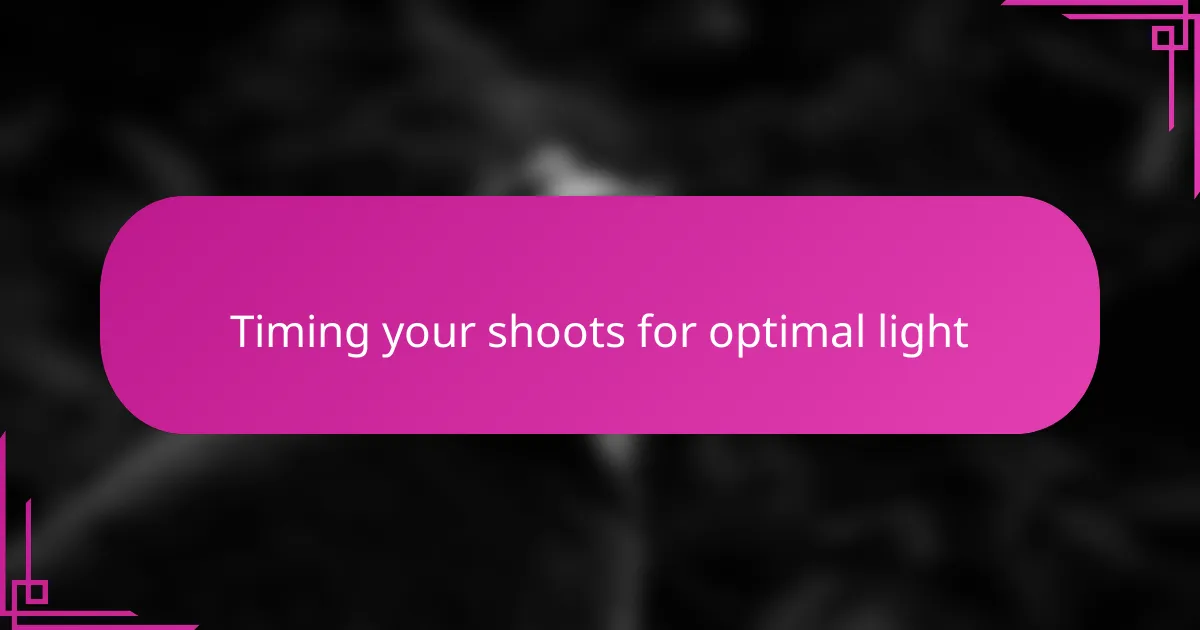
Timing your shoots for optimal light
Timing your shoots around the golden hours—the early morning just after sunrise and late afternoon before sunset—has always been a game changer for me. The light during these times is softer and warmer, wrapping subjects in a natural glow that feels both intimate and magical. Have you ever noticed how a room drenched in this light suddenly seems more alive, almost as if it’s sharing a secret?
Midday light, on the other hand, can be tricky but also offers opportunities if you know what to look for. I’ve learned to use the sharper shadows it creates to add drama and contrast, especially when shooting still life or architectural details indoors. It’s interesting how the timing of the sun can completely alter the mood of your photo—even when the setting stays the same.
I often plan my shoots by tracking the sun’s path through my windows, sometimes revisiting the same spot at different times of day just to see how the light shifts. This becomes almost a daily meditation, a way for me to connect deeply with my surroundings and anticipate the fleeting moments when the light is just right. Have you tried this? It really changes the way you understand and work with natural light indoors.
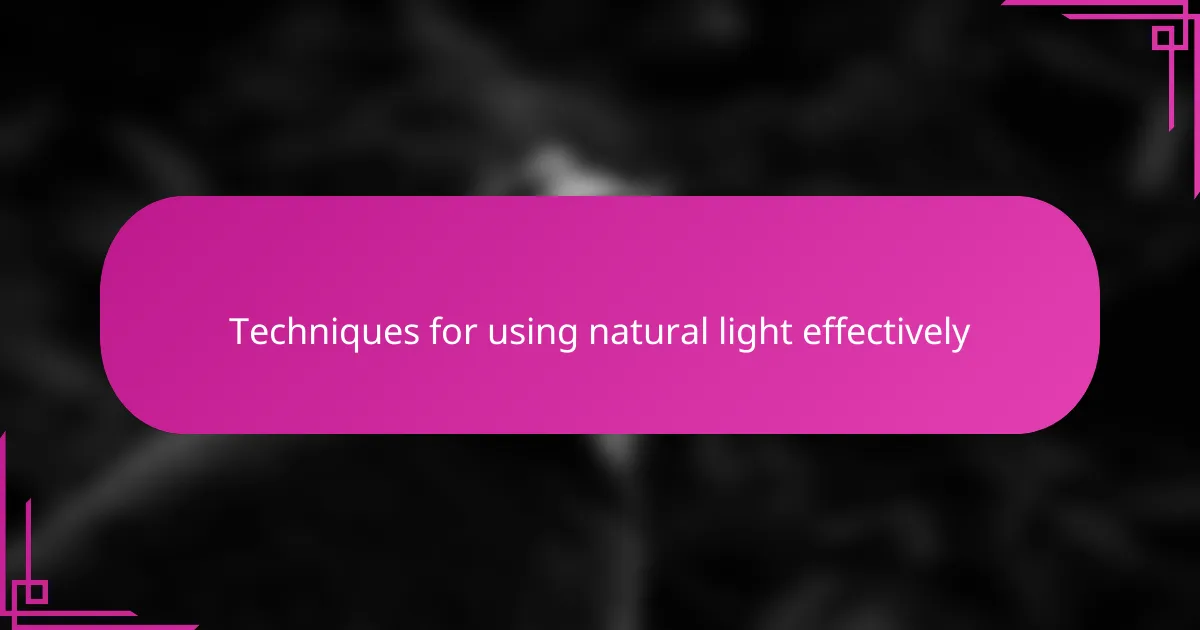
Techniques for using natural light effectively
When working with natural light indoors, I’ve found that positioning my subject close to windows makes all the difference. The soft, side-lit effect brings out details and adds depth without harshness—something I cherish especially when capturing portraits. Have you ever noticed how just a slight shift toward or away from a window can completely change the mood of your photo?
Diffusing direct sunlight is another technique I rely on regularly. I often use sheer curtains or even a simple white bedsheet to soften strong rays that might otherwise create unflattering shadows or blown-out highlights. This gentle filtering transforms the light into a painterly glow, which feels more natural and flattering to both people and still objects.
Don’t underestimate the power of reflected light, either. I sometimes place white boards or foam cores opposite a window to bounce light back onto my subject, filling in shadows and creating a balanced, even illumination. It’s like having a silent assistant who quietly lifts the scene without stealing the spotlight from that beautiful natural sunlight streaming in. Have you tried this approach? It’s a subtle trick but one that has elevated many of my indoor shoots.
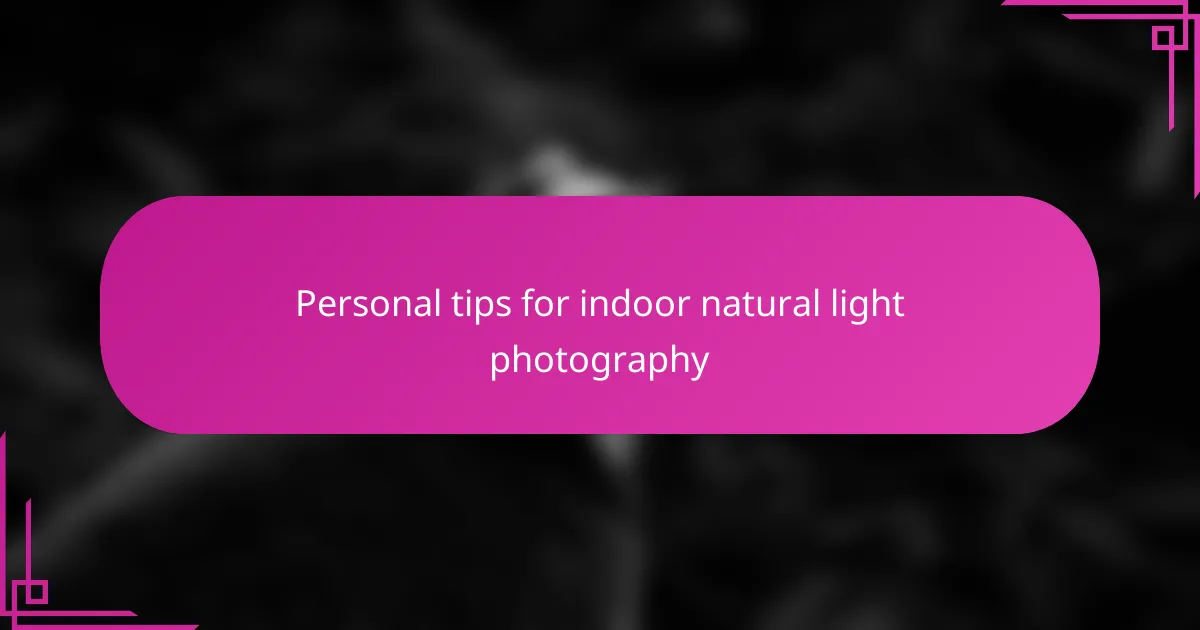
Personal tips for indoor natural light photography
One personal tip I swear by is to be patient and observe how the light moves and changes throughout the day. I remember a shoot where I almost gave up, but waiting for just a few more minutes let me catch that soft, golden light spilling perfectly across the room—turning an ordinary shot into something truly magical. Have you ever found that a moment’s pause reveals the best light indoors?
Another trick I use is to embrace shadows rather than fight them. Early on, I thought shadows were obstacles, but now I see them as creative tools that add depth and mood. Playing with where the shadows fall can turn a flat image into one full of intrigue. It’s fascinating how a little darkness can bring so much life to a photo, isn’t it?
Lastly, I always recommend experimenting with different angles to capture natural light. Sometimes, the most flattering glow comes not from facing the window directly, but from turning your subject slightly or shooting from above. Changing your perspective often surprises you, revealing textures and tones you hadn’t noticed before. Have you tried moving around enough to let the light surprise you? It’s one of the joys of indoor natural light photography for me.
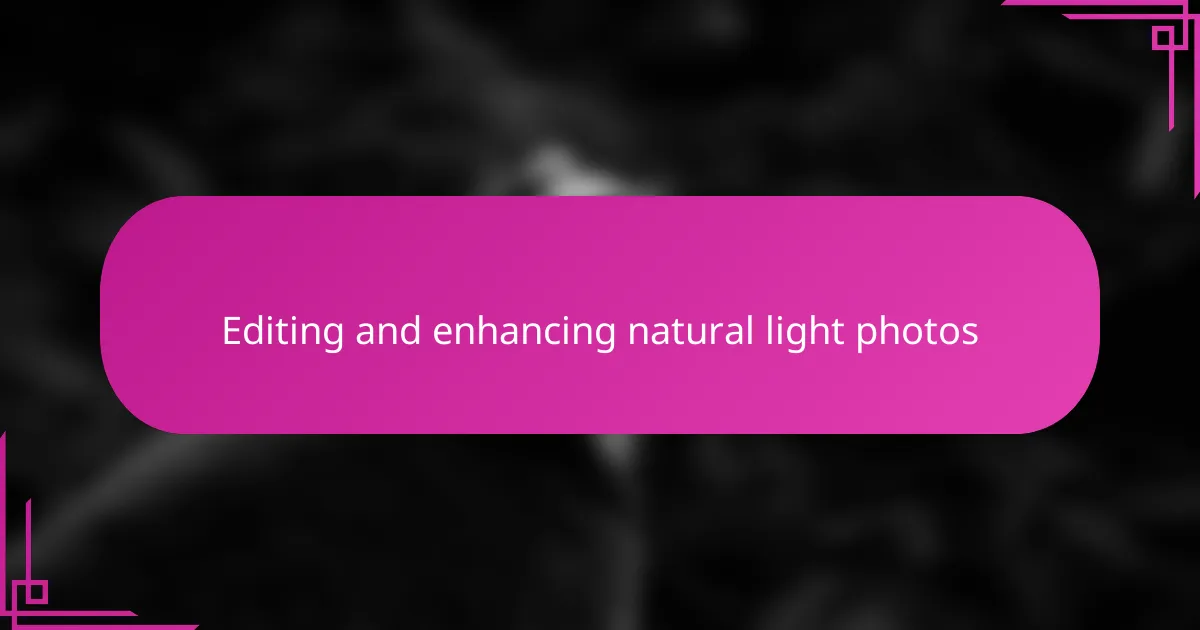
Editing and enhancing natural light photos
When it comes to editing photos taken in natural light, I like to start by preserving the softness that drew me to the shot in the first place. I often adjust exposure gently, avoiding heavy tweaks that could wash out those delicate highlights or shadows. Have you noticed how a subtle boost in warmth can bring back that cozy feeling you felt standing there?
I also pay close attention to color balance. Sometimes the natural light indoors leans a bit cool or too warm depending on the time of day, and a small correction can make the colors pop without losing that authentic vibe. It’s like fine-tuning a piece of music—just enough to enhance but never to overpower.
Finally, I’m a fan of using selective adjustments—brightening the subject’s face or adding a touch of clarity to textures like fabric or wood grain. These small touches help me guide the viewer’s eye while keeping the natural light’s honesty intact. Do you find yourself hesitant to over-edit your natural light photos? I’ve learned that less truly is more in this context.